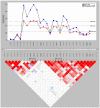Analysis of SNPs and haplotypes in vitamin D pathway genes and renal cancer risk
- PMID: 19753122
- PMCID: PMC2737618
- DOI: 10.1371/journal.pone.0007013
Analysis of SNPs and haplotypes in vitamin D pathway genes and renal cancer risk
Abstract
In the kidney vitamin D is converted to its active form. Since vitamin D exerts its activity through binding to the nuclear vitamin D receptor (VDR), most genetic studies have primarily focused on variation within this gene. Therefore, analysis of genetic variation in VDR and other vitamin D pathway genes may provide insight into the role of vitamin D in renal cell carcinoma (RCC) etiology. RCC cases (N = 777) and controls (N = 1,035) were genotyped to investigate the relationship between RCC risk and variation in eight target genes. Minimum-p-value permutation (Min-P) tests were used to identify genes associated with risk. A three single nucleotide polymorphism (SNP) sliding window was used to identify chromosomal regions with a False Discovery Rate of <10%, where subsequently, haplotype relative risks were computed in Haplostats. Min-P values showed that VDR (p-value = 0.02) and retinoid-X-receptor-alpha (RXRA) (p-value = 0.10) were associated with RCC risk. Within VDR, three haplotypes across two chromosomal regions of interest were identified. The first region, located within intron 2, contained two haplotypes that increased RCC risk by approximately 25%. The second region included a haplotype (rs2239179, rs12717991) across intron 4 that increased risk among participants with the TC (OR = 1.31, 95% CI = 1.09-1.57) haplotype compared to participants with the common haplotype, TT. Across RXRA, one haplotype located 3' of the coding sequence (rs748964, rs3118523), increased RCC risk 35% among individuals with the variant haplotype compared to those with the most common haplotype. This study comprehensively evaluated genetic variation across eight vitamin D pathway genes in relation to RCC risk. We found increased risk associated with VDR and RXRA. Replication studies are warranted to confirm these findings.
Conflict of interest statement
Figures


References
-
- Norman AW. Sunlight, season, skin pigmentation, vitamin D, and 25-hydroxyvitamin D: integral components of the vitamin D endocrine system. Am J Clin Nutr. 1998;67:1108–1110. - PubMed
-
- Trump DL, Hershberger PA, Bernardi RJ, Ahmed S, Muindi J, et al. Anti-tumor activity of calcitriol: pre-clinical and clinical studies. J Steroid Biochem Mol Biol. 2004;89:519–526. - PubMed
-
- Ordonez-Moran P, Larriba MJ, Pendas-Franco N, Aguilera O, Gonzalez-Sancho JM, et al. Vitamin D and cancer: an update of in vitro and in vivo data. Front Biosci. 2005;10:2723–2749. - PubMed
-
- Valdivielso JM, Fernandez E. Vitamin D receptor polymorphisms and diseases. Clin Chim Acta. 2006;371:1–12. - PubMed
-
- Walters MR. Newly identified actions of the vitamin D endocrine system. Endocr Rev. 1992;13:719–764. - PubMed
Publication types
MeSH terms
Substances
Grants and funding
LinkOut - more resources
Full Text Sources
Other Literature Sources
Medical

